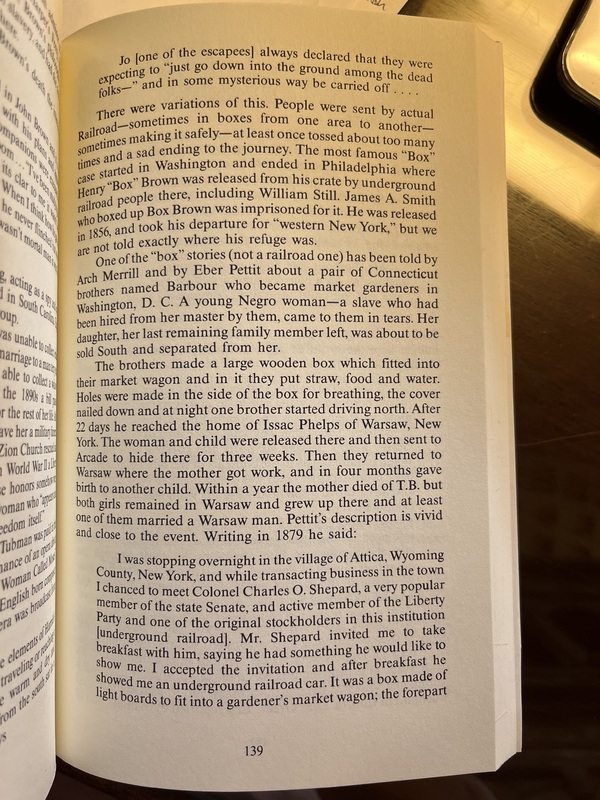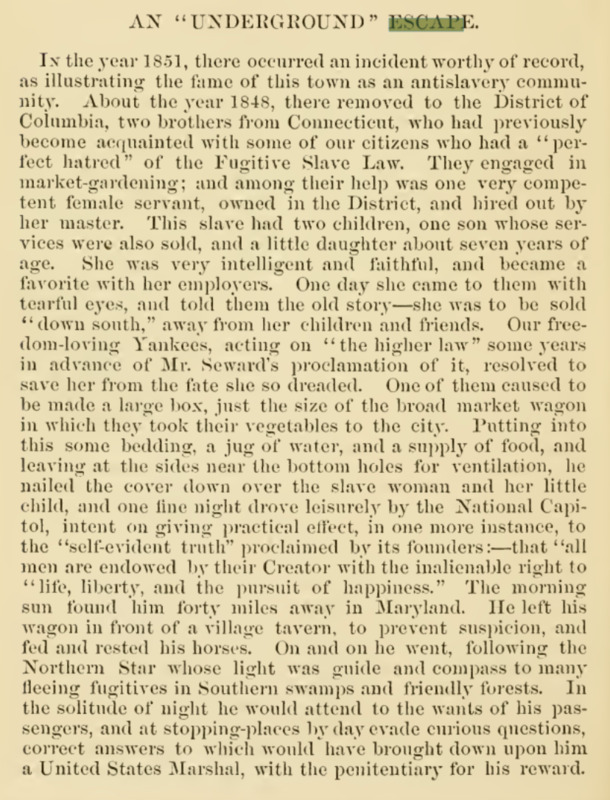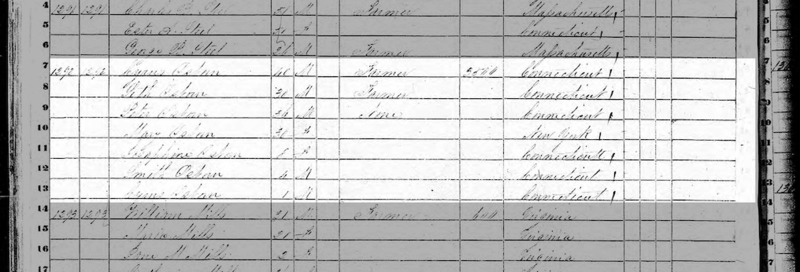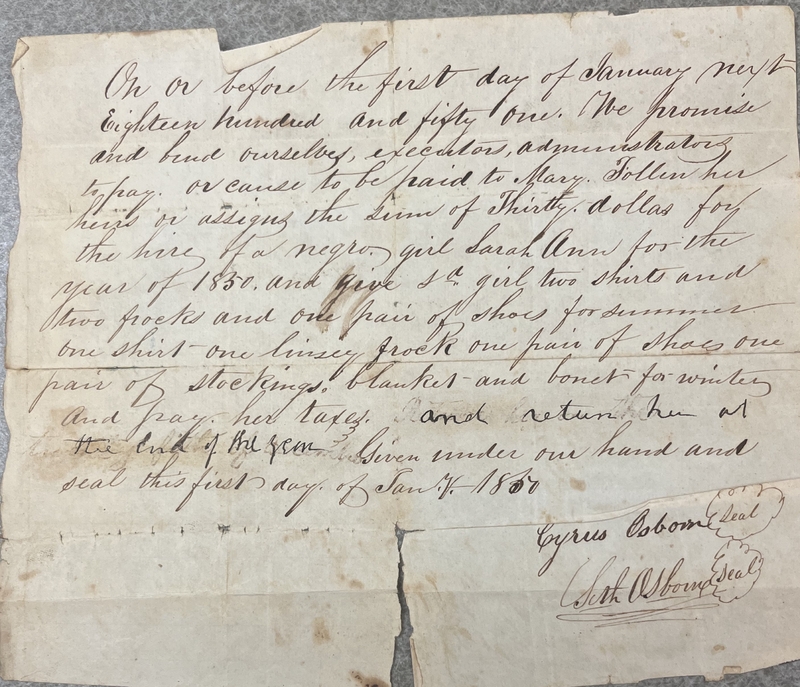Secret Agent
If this is the ending to Sarah Ann’s story, how could she have made it there? That point of connection has to be the Underground Railroad Agent. It is fairly well known in the Fairfax area that the Sully Plantation was a stop on the Underground Railroad, but geographically that was located too far for Sarah Ann to have employed them since her last known location was the Courthouse. The only other clues as to how she and her daughter could have escaped and with whose help, came from sources in New York which did not exactly give a unified answer.
While the detail of how they escaped laying in the bottom of a vegetable cart remained consistent, the written histories from the North seem to be in conversation with and almost contradict one another in their claims of who was driving the horse drawn cart. The Underground Railroad: An Encyclopedia of People, Places, and Operations by Mary Ellen Snodgrass (See document to the left) is the first relevant source.[i] Here, in the section dedicated to Mary Eliza Burghardt (the 7 year old Mary who arrived and survived in New York), Snodgrass claims that a man named Cyrus Osborne smuggled them North. She claimed Osborne was a greengrocer from Washington D.C. and cited Helene Phelan’s And Why Not Every Man?, but nowhere in that text could I find any mention of a Cyrus Osborne. Phelan does, however, mention an oral history of a woman and child rescued from enslavement in the D.C. area in the exact same way, with vegetables on top of a horse drawn cart (Slide 1 below).[ii] This story claims that the agents who helped were actually two brothers from Connecticut named Barbour. Could this be just another parallel story, or was it actually Sarah Ann? In 1869, Andrew Young wrote a history of the town of Warsaw, New York and included the story of Mary Eliza, Charles William, and their mother’s escape from the South (Slide 2 below). He claimed that they were assisted by two brothers from Connecticut, and described the same story of vegetables in a cart, following the same time table, but left the Brothers unnamed.[iii] These sources and the conversations being had between them seemed to only invalidate each other until I found the missing link that ties not only these agent claims together, but also connects the New York and Fairfax sides of Sarah Ann’s story together.
The figures below show census records proving the existence of Cyrus Osborne and his brothers Seth and Peter, living in the Fairfax/Falls Church area as farmers. They had moved there from where they were born in Connecticut. All three of the sources were correct in their own way and finding Cyrus Osborn brings together the loose ends and partially completes Sarah Ann's geographical picture. The location of their farm is included in the interactive map at the end of this page. Interestingly, the 1850 census record notes 3 children in the Osborn home (8, 4, and 1), similar ages to Sarah Ann’s daughter Mary and soon to be born son Charles William.[iv] Was there a parental or fatherly empathy felt by Cyrus and his brothers that let them see their own family reflected in that of Sarah Ann?
The most significant piece of evidence tying the Osborn brothers to Sarah Ann and her escape is a lawsuit between Cyrus and Seth and Mary Follin just two years after her escape.v In 1852 Mary Follin sued Cyrus and Seth Osborn for $30, the same amount listed in her runaway ad, regarding Sarah Ann and her daughter’s disappearance. As it turns out, the Osborns had known Sarah Ann for quite some time. They had hired her, and presumably her daughter Mary, for the year of 1849 to come and work with them and live on their land. At the start of 1850, they decided to renew this deal and drew up a new deed. In it, they promised to pay Mary Follin $30, provide Sarah Ann with a certain number of clothing items for the year, and to pay her taxes in exchange for another year of labor. The Osborns claimed that after drawing up this deed in January 185, they sent Sarah Ann with it back to the Follin Plantation so that Mary Follin could sign the deed, but that they never saw her again. We know that this was a lie. The question is, did Mary?
The basis of this lawsuit was that the Osborns had never paid the $30 for having rented Sarah Ann out in 1850, but they alleged that they did not have her for that year and therefore should not be made responsible for that amount of money. Mary Follin countered with the claim that from the loss of Sarah Ann, her daughter, and her unborn child, she had truly lost over $500 and that the Osborns had agreed to return her at the end of the deed period, which obviously had not occurred. The Osborns disputed the last notion, arguing that returning Sarah Ann had never technically been a part of the deal and pointed to the hand-written deed that had evidence of falsification. It is very clearly visible that the last sentence had been erased and replaced with “and return her at the end of the year” in a completely different handwriting.
This most recent finding begs the question of whether Mary Follin knew of the Osborns' involvement in Sarah Ann’s disappearance, or if this was truly a dispute over money. It also complicates the question of paternity regarding Sarah Ann’s younger child. It is clear that he is mixed race from his census documentation later on in New York. However, if the Osborns had rented Sarah Ann for the year 1849, that means she must have become pregnant when she was working for them. Is it possible that it was still one of the Follin men who impregnated her? Sure. Is it also possible that it was one of the Osborns or a man who interacted with her on their farm? Yes. It could have been part of the reason why they helped her escape, and that would certainly complicate their abolitionist legacy.
The biggest lead to follow from this finding is another earlier lawsuit against Cyrus and Seth. In 1848, there is record of them being sued by another white land-owning widow in Fairfax County because they had not paid the agreed- upon amount for the lease of an enslaved man named George. The Osborns had only moved from Connecticut a few years prior and so it is possible that this was their first attempt at freeing an enslaved person from the area. If this was a pattern of emancipation and escape, that could tell us more about their mission and potentially Charles William’s paternity.
This is the first explicit public record of the Osbornes' involvement in the Underground Railroad, there is no literature within or outside of Fairfax County that tells their story. Because of that, it would be worth asking if there is a family history that has been passed down to Osborne descendants that could help us find out more about Sarah Ann. More powerfully, since Cyrus Osborne did in fact smuggle Sarah Ann and her daughter to Warsaw, New York in the back of a vegetable cart, how many other enslaved people did he transport in his lifetime, and was George the first?
[i] Snodgrass, Mary Ellen. “Burghardt, Mary Eliza.” In The Underground Railroad : An Encyclopedia of People, Places, and Operations, 87. Armonk, N.Y.: M.E. Sharpe, 2008. https://archive.org/details/undergroundrailr0000snod/page/86/mode/2up.
[ii] Phelan, Helene. And Why Not Every Man: An Account of Slavery, the Underground Railroad, and the Road to Freedom in New York’s Southern Tier. Empire State Books, 1987.
[iii] Young, Andrew W. “An ‘Underground’ Escape.” In History of the Town of Warsaw, New York, 364. Buffalo, New York, 1869.
[iv] “1850 Census Cyrus Osborn.” In 1850 United States Federal Census [29], 1850 (roll M432). National Archives and Records Administration, Records of the Bureau of the Census. https://www.ancestry.com/discoveryui-content/view/15006035:8054.
[v] “Mary Follin vs. Cyrus Osborn,” Term Papers 1850-1859, 6/1857, Box 038, Folder 1857-202, Fairfax Circuit Court Historic Records.




